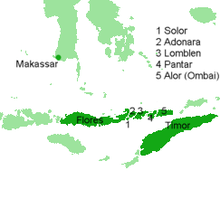Apollonius Schotte (seafarer)
Apollonius Schotte , also Apoll Schotte , Apolljnius Schotte or Apollonius Scotte (* before 1570 in Middelburg , Netherlands ; † November 25 or 26, 1613 near Jakarta ); was a Dutch captain in the Dutch East India Company (VOC).
Schotte was born to Jacob Schotte and his first wife Leuntje (Apollonia) Thoor. His impetuosity at a young age is said to have been the reason why he hired the VOC and left the Netherlands for East Asia. He is reported for the first time in July 1608, as a passenger on board the Patria in the fleet of Admiral Paulus van Caerden . He had left Texel on April 20, 1606 and reached the Sunda Strait on January 6, 1608 and then drove on to the Moluccas on the island of Makian , west of Halmahera . Makian was rich in cloves . Van Caerden appointed Scots in command of the island and chief merchant. Schotte worked successfully at this post until 1612. In 1609 he helped Vice Admiral Hoen to conquer the Bacan Islands . Later, Schotte fought successfully against Spaniards , Portuguese and the Sultanate of Tidore on Moti . Schotte stood out so well that his opponents offered a bounty of 1,500 reals. In the subsequent negotiations with the Spaniards on a twelve-year armistice, Schotte acted as negotiator.
Schotte was the first European to challenge Portuguese supremacy on the Lesser Sunda Islands . In 1612 he signed a contract with the local rulers on Buton on behalf of the VOC. On January 17, 1613, Schotte reached the island of Solor , on which the Portuguese main base for the Lesser Sunda Islands was located. From here one controlled the sandalwood trade between Timor and the recipients in China and India . Schottes ships fired at the fortress while a landing party burned the city to the ground. The Portuguese commander Alvarez surrendered on April 20, and several thousand Portuguese, mestizo and locals left Solor for Larantuka . The Dutch occupied the fortress and renamed it Fort Henricus.
On February 7th, while the siege of Solor was still in progress, Schotte sent an expedition from the ship Halbmond and a captured Portuguese Galiot to Timor, which landed two Portuguese ships there. On June 4, Schotte himself landed on board the Patane in Mena , Timor. The rulers of Mena and Asson were induced to form an alliance with the Dutch and guarantee supplies of sandalwood. Then Schotte drove on along the Timorese coast and concluded several treaties with local rulers, which later formed the basis of all Dutch claims in West Timor . Finally he also conquered the Portuguese fort near Kupang and left behind a small occupying force, just as in Mena.
Schotte drowned while bathing in the Jakarta River in 1613 .
Immediately after his death, the Dutch withdrew from the Lesser Sunda Islands for a few years. In 1615 they first gave up Solor, then in 1616 their bases on Timor and Flores . Nevertheless, Schott's intervention in Timor marked the beginning of the political division of the island, initially between the Dutch and Portuguese, and today between the states of Indonesia and East Timor .
literature
- Apollonius Schotte: Relation du Voyage in Recueil des Voyages qui ont semi lj 'Etablissement et atLX Progris de la Compagnie de Indes Orientales Formie dans leg Provinces Unies des Pays-Bas , Tome IV, Etienne Roger, Amsterdam, 1705, pp. 207-214 .
Individual evidence
- ↑ a b c d encyclopedievanzeeland.nl: Apollonius Schotte , accessed on December 2, 2017.
- ^ A b c Archive.org: "The East and West Indian mirror: being an account of Joris van Speilbergen's voyage round the world (1614-1617), and the Australian navigations of Jacob Le Maire"
- ↑ Geoffrey C. Gunn: History of Timor , p. 19 ( Memento of the original of March 24, 2009 in the Internet Archive ) Info: The archive link was automatically inserted and not yet checked. Please check the original and archive link according to the instructions and then remove this notice. - Lisbon Technical University (PDF file; 805 kB)
- ↑ History of Timor, p. 28
| personal data | |
|---|---|
| SURNAME | Scotsman, Apollonius |
| ALTERNATIVE NAMES | Schotte, Apollo; Schotte, Apollinius; Scotte, Apollonius |
| BRIEF DESCRIPTION | Dutch captain of the Dutch East India Company |
| DATE OF BIRTH | before 1570 |
| PLACE OF BIRTH | Middelburg , Netherlands |
| DATE OF DEATH | November 25, 1613 or November 26, 1613 |
| Place of death | near Jakarta |
